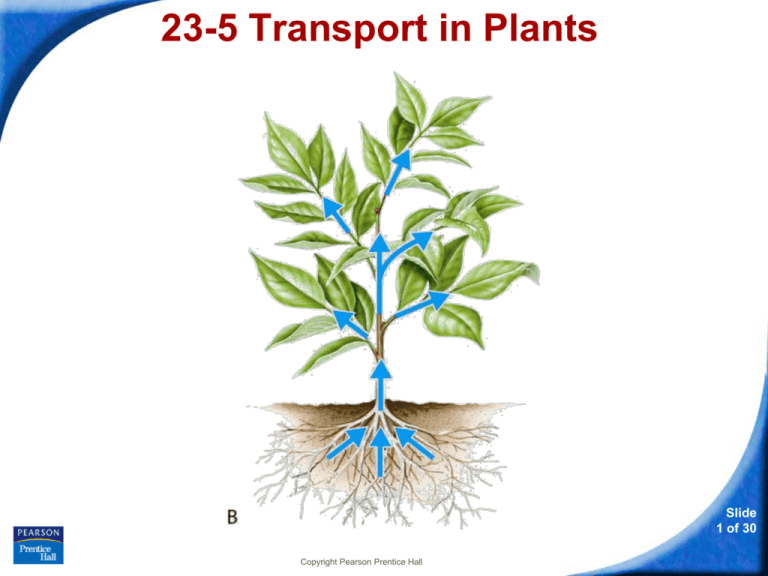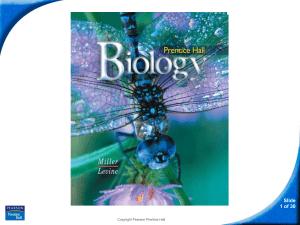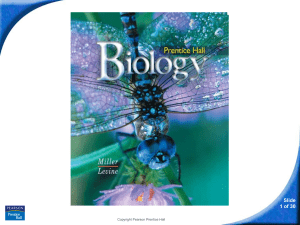
23-5 Transport in Plants
Slide
1 of 30
Copyright Pearson Prentice Hall
23-5 Transport in Plants
Water Transport
The combination of root pressure, capillary
action, and transpiration provides enough
force to move water through the xylem
tissue of even the tallest plant.
Slide
2 of 30
Copyright Pearson Prentice Hall
23-5 Transport in Plants
Water Transport
Cohesion is the attraction of molecules of the same
substance to each other.
Adhesion is the attraction between unlike molecules.
Slide
3 of 30
Copyright Pearson Prentice Hall
23-5 Transport in Plants
Water Transport
The tendency of water to
rise in a thin tube is called
capillary action.
Water is attracted to the
walls of the tube, and
water molecules are
attracted to one another.
Slide
4 of 30
Copyright Pearson Prentice Hall
23-5 Transport in Plants
Water Transport
Capillary action causes
water to move much
higher in a narrow tube
than in a wide tube.
Slide
5 of 30
Copyright Pearson Prentice Hall
23-5 Transport in Plants
Water Transport
Tracheids and vessel elements form hollow
connected tubes in a plant.
Capillary action in these structures causes water to
rise well above the level of the ground.
Slide
6 of 30
Copyright Pearson Prentice Hall
23-5 Transport in Plants
Water Transport
Transpiration
In tall plants, the major force
in water transport comes
from the evaporation of
water from leaves during
transpiration.
When water is lost through
transpiration, osmotic
pressure moves water out of
the vascular tissue of the
leaf.
Slide
7 of 30
Copyright Pearson Prentice Hall
23-5 Transport in Plants
Water Transport
The movement of water
out of the leaf “pulls”
water upward through the
vascular system all the
way from the roots.
This process is known as
transpirational pull.
Slide
8 of 30
Copyright Pearson Prentice Hall
23-5 Transport in Plants
Water Transport
Controlling Transpiration
The water content of the leaf is kept relatively
constant.
When there is a lot of water, water pressure in the
guard cells is increased and the stomata open.
Excess water is then lost through the open
stomata by transpiration.
Slide
9 of 30
Copyright Pearson Prentice Hall
23-5 Transport in Plants
Water Transport
When water is scarce, the opposite occurs.
Water pressure in the leaf decreases. The guard cells
respond by closing the stomata.
This reduces further water loss by limiting
transpiration.
When too much water is lost, wilting occurs. When a
leaf wilts, its stomata close and transpiration slows
down. This helps a plant conserve water.
Slide
10 of 30
Copyright Pearson Prentice Hall
23–5
Click to Launch:
Continue to:
- or -
Slide
11 of 30
Copyright Pearson Prentice Hall
23–5
In a plant stem, water moves from
a. leaves to roots through xylem.
b. roots to leaves through xylem.
c. leaves to roots through phloem.
d. roots to leaves through phloem.
Slide
12 of 30
Copyright Pearson Prentice Hall
23–5
Which of the following is NOT involved in the
movement of water in xylem tissue?
a. cohesion
b. osmosis
c. capillary action
d. adhesion
Slide
13 of 30
Copyright Pearson Prentice Hall
23–5
In very tall trees, which of the following is
primarily involved in moving water to the top of
the tree?
a. transpirational pull
b. capillary action
c. root pressure
d. osmosis
Slide
14 of 30
Copyright Pearson Prentice Hall











